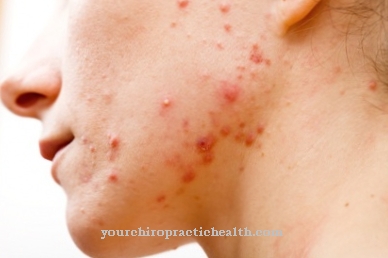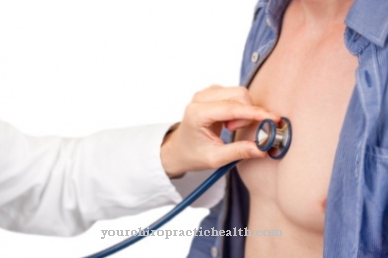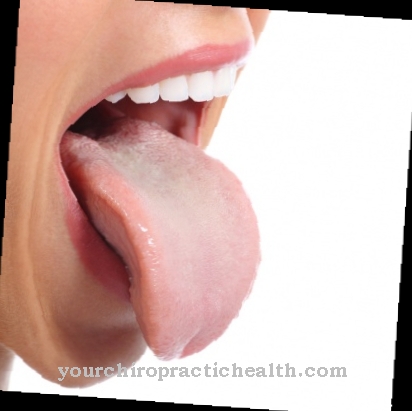Of the gothic palate is an abnormally high roof of the mouth. The phenomenon is the symptom of various malformation complexes and thus usually has a mutation as the cause. Since drinking and eating disorders can occur with severe symptoms, surgical correction is usually the treatment of choice.
What is a gothic palate?

© Elroi - stock.adobe.com
The palate forms the roof of the oral cavity and at the same time corresponds to a floor structure of the nasal cavity. The hard palate separates the oral cavity from the nasal cavity. The anatomical structure serves as an abutment for the tongue when swallowing. The soft palate separates the oral cavity from the nasopharynx when swallowing.
In addition, the palate takes on important functions in articulation and is therefore a relevant tool for communication. The tissue of the palate can be affected by various malformations and abnormalities that affect the functions of the palate. Of a gothic palate is the talk when the anatomical structure is too high.
The Gothic palate corresponds to a congenital malformation of the palate tissue, which does not necessarily have to be of disease value. If it is less pronounced, it may be an anomaly that does not have any further impact. A strong expression is associated with disease value and hampers the everyday life of the patient considerably.
causes
The cause of a palate that is set too high is to be found in embryonic development or genetics. The phenomenon cannot be acquired, but is fundamentally a congenital malformation. In most cases, the malformation of the palate points to a superordinate syndrome and can therefore only be interpreted as a symptom of a certain primary disease.
The pointed or steep palate is, for example, the symptom of syndromes such as Marfan syndrome, Möbius syndrome, Noonan syndrome, Cornelia de Lange syndrome, Pallister-Killian syndrome, Sotos syndrome and the Cohen syndrome or refers to diseases such as trisomy 8. The primary cause of the palatal malformation is in most cases a genetic mutation.
The syndromes mentioned are associated with heredity. As a symptom of these syndromes, the Gothic palate can also be subject to familial accumulation and thus be passed on in different inheritance patterns. Which mutations and developmental disorders cause the malformations in each individual case depends on the respective disease framework.
Patients with a Gothic palate experience a number of different symptoms. The main symptom of the malformation manifests itself in the form of an excessively high palate structure which, depending on its severity, affects the function of the palate to a greater or lesser extent. Because of this, patients often experience problems with swallowing.
They choke frequently and can even be prone to suffocation. In particular, poor drinking is a common symptom accompanying malformation of the palate. In addition, food components can be aspirated. In severe cases, patients sometimes choke on their own saliva, which they often aspirate, for example.
Speech development in patients with a pronounced Gothic palate is usually difficult. Speech disorders occur. The other symptoms associated with the Gothic palate depend on the underlying cause of the deformity. Diseases such as Marfan's or Möbius syndrome are complexes of malformations that are associated with deformities in a wide variety of organs and body tissues.
Diseases with this symptom
- Noonan's Syndrome
- Trisomy 8
- Cornelia de Lange Syndrome
- Prader-Willi Syndrome
- Pallister-Killian Syndrome
- Sotos syndrome
Diagnosis & course
The diagnosis of a Gothic palate is usually made based on x-ray imaging. This X-ray imaging not only prompts swallowing disorders. In the case of symptom complexes such as the syndromes mentioned above, x-ray imaging is usually used to assess and detect the cause of obvious malformations.
A strongly Gothic palate worsens the prognosis of various malformation syndromes. The risk of food and fluid aspiration is high. For this reason, an untreated palate is often associated with a relatively high mortality rate.
Complications
A Gothic palate can lead to sometimes serious complications due to late or inadequate treatment on the one hand and the therapeutic measures on the other. If the palate remains untreated, dehydration, malnutrition and various deficiency symptoms can occur due to the aspiration of food and fluids. In severe cases, a Gothic palate can alter the flow of saliva in such a way that it leads to attacks of suffocation and, as a result, to the death of the patient.
The inability to drink is a frequent accompanying symptom of a malformation of the palate and is often associated with aspiration of the food ingested. If the malformation is corrected surgically at an early stage, long-term consequences can be averted. However, normal language development is unlikely and can only be secured to a certain extent by speech therapy measures. Even with an early operation, those affected are not able to use the soft and hard palate for sound formation. This leads to linguistic restrictions, which are compensated by special techniques as part of the therapeutic measures.
The operation itself also harbors complications: if the relocation of the palate structure fails, the patient may have to be fed intravenously to prevent further attacks of suffocation. If no further operation is possible, the symptoms persist and the patient may be permanently dependent on artificial nutrition. Early treatment significantly reduces the risk of such complications.
When should you go to the doctor?
The gothic palate is a congenital malformation of the palate and is differently pronounced. The Gothic palate is often diagnosed shortly after birth as part of early childhood medical examinations. This malformation of the palate does not always have to be corrected. If the gothic palate is recognized early, parents should watch their child closely and keep in close contact with the doctor or pediatrician. If this particular palate shape has not yet been recognized, problems with swallowing and speaking will arise early if the deviation from the norm is too great, which in turn will soon lead to a doctor's visit.
It is important to know that the palate separates the oral cavity and the nasal cavity. It acts as the roof of the oral cavity and the floor of the nasal cavity. The higher the curve of the Gothic palate, the greater the difficulty it causes. A slightly raised Gothic palate often does not need to be treated.
Stronger forms, on the other hand, have to be corrected surgically, as the Gothic palate then has the character of a massive physical handicap and, without treatment, would significantly impair the child's physical and psychological development. Impaired drinking in infants, difficulty ingesting food, and speech disorders are distinctive effects of a Gothic palate. With this anatomical malformation, a visit to the doctor is a must for parents with their child.
Doctors & therapists in your area
Treatment & Therapy
In the context of malformation syndromes, no therapeutic options are available for the causal treatment of a Gothic palate. Causal therapy approaches eliminate the cause of a specific disease. In the closer context, the only possible causal therapy for the syndromes mentioned is gene therapy. However, these approaches are not yet in the clinical phase.
For this reason, the Gothic palate is treated symptomatically in the context of malformation syndromes. Treatment of the anomaly is usually necessary, even if it is minor, and should take place as early as possible to ensure that the patient is able to eat and breathe.
The treatment is surgically and surgically and largely corresponds to a relocation of the palate structure to the anatomically intended location. If there are contraindications to the operation or if the repositioning fails, the patient may need to be artificially fed and intravenously supplied with fluids if the symptoms are severe to avoid attacks of suffocation.
Salivary medication can prevent attacks of suffocation caused by one's own salivation. If the Gothic palate is initially asymptomatic, it doesn't necessarily need to be corrected. At the latest during language development, however, symptoms will appear, even if they are extremely subtle.
In order to ensure normal language development, the patient may need to be accompanied by speech therapy. Since it is anatomically not possible for them to form sounds with the help of the soft or hard palate, speech therapy does not fix the actual cause of the speech disorder, but merely provides the person concerned with techniques for compensation.
Outlook & forecast
In most cases, a Gothic palate leads to various problems and ailments when eating and drinking. The extent of these complaints depends heavily on the development of the palate and its malformation. In most cases, the affected person is then dependent on an operation to remedy these disorders. Above all, the risk of aspiration is increased by the Gothic palate, so that children are exposed to an increased risk.
It is not uncommon for the disease to lead to dehydration or malnutrition. Underweight is a very unhealthy condition for the human body and should definitely be treated. If the complaint is removed in childhood, there are usually no consequential damages or complications.
The Gothic palate can also cause speech disorders. These can be treated in various therapies.
prevention
The Gothic palate, in most cases, is the symptom of a genetic mutation. Because for most factors hardly avoidable factors of the internal structure and external world play a role, it is difficult to prevent the Gothic palate. Genetically hereditary syndromes with symptomatic gothic palates can only be prevented through genetic counseling.
You can do that yourself
A Gothic palate does not always require treatment by a doctor. Typical complaints as a result of the deformity can be reduced with a number of measures and home remedies. Speech disorders as a result of a Gothic palate can be reduced, among other things, through speech therapy techniques and daily practice. Preparations from the pharmacy as well as salivary foods such as pretzel sticks or dried fruit help against salivation.
To prevent dehydration as a result of possible fluid aspiration, sufficient water should be drunk. A balanced diet prevents malnutrition. If you have severe symptoms, you should always see a doctor with a Gothic palate. The ENT doctor prescribes medication against the excessive flow of saliva and may refer the affected person to a speech therapist, who will take further steps. At the same time, the palate should be spared so that the already irritated oral cavity is not further burdened.
To prevent the development of a Gothic palate, parents should always encourage their children to breathe through the nose. In addition, a doctor should be consulted at the first signs of a palate, as the misalignment may still be corrected.













.jpg)

.jpg)
.jpg)











.jpg)